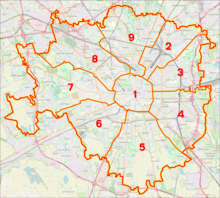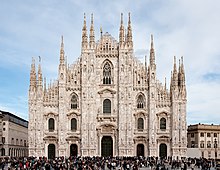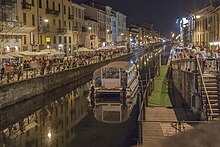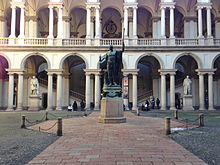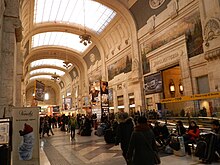Milan
| Milano Milan |
||
|---|---|---|
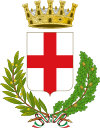
|
|
|
| Country | Italy | |
| region | Lombardy | |
| Metropolitan city | Milan (MI) | |
| Local name | Milano | |
| Coordinates | 45 ° 28 ' N , 9 ° 11' E | |
| height | 120 m slm | |
| area | 182 km² | |
| resident | 1,396,059 (Dec. 31, 2019) | |
| Postal code | 20100 | |
| prefix | 02 | |
| ISTAT number | 015146 | |
| Popular name | Milanesi, Meneghini | |
| Patron saint | Ambrose of Milan | |
| Website | www.comune.milano.it | |
 Clockwise from above: Porta Nuova high-rise district , Castello Sforzesco , Teatro alla Scala , Galleria Vittorio Emanuele II , Milano Centrale railway station , Arco della Pace and Milan Cathedral . |
||
Milan ( Italian Milano [miˈlaːno] , Lombard Milan [miˈlã (ŋ)] , Latin Mediolanum ) is the second largest city in Italy and the capital of the Lombardy region and the metropolitan city of Milan with around 1.4 million inhabitants . In 2006 the metropolitan region was the largest Italian metropolitan area with 7.4 million inhabitants.
Once founded by Celtic settlers, the city experienced a rapid boom during the Roman Empire . Milan has been under the influence of German , French and Austrian emperors in its history and grew to become the largest industrial city in the country after the unification of Italy . Today it is the leading cultural, media and fashion metropolis in Italy, a university town and an international financial center as the seat of the Italian Stock Exchange . It is home to a world cultural heritage site , historically significant buildings and diverse art treasures that attract several million tourists each year. The exhibition center is thanks to its strategic location in the northern Italian Po Valley , a hub of rail and motorway network and the second largest aviation hub in Italy with three international airports.
Geography and climate
Geographical location
Milan is located in the northwestern Po plain , roughly halfway between the Po River in the south and the foothills of the Alps in the north. The core city is located in a largely flat plain, the highest point is 122 m above sea level. Two rivers run through the city: the Olona in the west and the Lambro in the east. Medieval canals, the Navigli , connect Milan with the northern Italian lakes and the Lombard rivers and were of decisive importance for the local economy until the middle of the 20th century.
The urban area covers an area of 182 km² with 1,343,230 inhabitants. The Milan agglomeration with a total of more than five million inhabitants includes numerous suburbs, which mainly extend north to Varese , Como , Lecco and Bergamo . Over 7.6 million people live in the metropolitan region .
Neighboring municipalities are Arese , Assago , Baranzate , Bollate , Corsico , Peschiera Borromeo , Rho , Sesto San Giovanni , Cormano , Cologno Monzese , Bresso , Novate Milanese , Vimodrone , Pero , Segrate , Settimo Milanese , Cusago , Cesano Boscone , Trezzano sul Naviglio , San Donato Milanese , Buccinasco , Rozzano and Opera .
City structure
Milan is divided into nine districts ( Municipi ). The original twenty districts were reduced in 1999. Today, Zona 1 encompasses the historic city center, all other eight districts are arranged as circular segments clockwise around the old town. The Milan districts are given partial sovereignty through a district council ( Consigli di Zona ) and a district president, including: in financial management.
- Municipio 1 : Centro Storico (city center)
- Municipio 2 : Stazione Centrale (Central Station) , Gorla , Turro , Greco , Crescenzago
- Municipio 3 : Città Studi, Lambrate , Porta Venezia
- Municipio 4 : Porta Vittoria, Forlanini
- Municipio 5 : Vigentino , Chiaravalle , Gratosoglio
- Municipio 6 : Barona, Lorenteggio
- Municipio 7 : Baggio , De Angeli, San Siro
- Municipio 8 : Fiera, Gallaratese, Quarto Oggiaro
- Municipio 9 : Garibaldi, Niguarda
climate
Milan is located in a subcontinental east side climate . The Alps and the Apennines form a natural barrier against weather influences from Northern Europe and the Mediterranean. As in many parts of northern Italy, very warm to hot summers, moderately cold, rainy winters and year-round high humidity are typical. In the winter months there is often heavy fog formation, occasionally snowfall, and in summer temperatures often rise to 35 ° C and more, especially in July and August. The hair dryer has a noticeable effect on the weather, which occurs particularly in spring. Strong gale-force storms can also occur at this time . The lowest measured temperature is −17.3 ° C, the highest 40.4 ° C.
| Milan, Lombardy | ||||||||||||||||||||||||||||||||||||||||||||||||
|---|---|---|---|---|---|---|---|---|---|---|---|---|---|---|---|---|---|---|---|---|---|---|---|---|---|---|---|---|---|---|---|---|---|---|---|---|---|---|---|---|---|---|---|---|---|---|---|---|
| Climate diagram | ||||||||||||||||||||||||||||||||||||||||||||||||
| ||||||||||||||||||||||||||||||||||||||||||||||||
|
Average monthly temperatures and rainfall for Milan, Lombardy
Source: WMO 1961–1990; Humidity, sunshine duration: wetterkontor.de
|
|||||||||||||||||||||||||||||||||||||||||||||||||||||||||||||||||||||||||||||||||||||||||||||||||||||||||||||||||||||||||||||||||||||||||||||||||||||||||||||||||||||
etymology
The name Milan is derived from the Italian Milano , which originated from the originally Latin name Mediolanum , which means "in the middle of the plain". The place name probably goes back less to the Latin medius “located in the middle” and planus “level” than to the Gaulish-Celtic roots * medios and * lanu, which have the same meaning . The same applies to the Lombard name Milàn . The people of Milan call themselves Milanées or Meneghìt .
story
From antiquity to the unification of Italy
Soon after 400 BC The area around Milan was settled by the Celtic Insubrians . 222 BC The Romans conquered this settlement and used the Latin name Mediolanum . After several centuries of Roman rule, Milan was made one of the imperial capital cities under Emperor Diocletian in 286 . In the 4th century, therefore, Roman rulers stayed here regularly, most recently Honorius . 313, the so-called. Was here Milan Edict (Milan Convention) announces, in which the Constantine and Licinius the Christians freedom of belief zusicherten.
In 402 the city was besieged by Visigoths , after which the imperial residence was moved to Ravenna ; 50 years later (452) the Huns under Attila sacked the city. In 539 the Ostrogoths conquered and destroyed Milan during the Gothic War against Emperor Justinian .
In 569 Milan fell to the Lombards until it became part of the Frankish Empire in 774 . During the war of Emperor Frederick I Barbarossa against the Lombard cities, Milan was largely destroyed in 1162.

Milan took on the leading role in the Lombardy League of Cities founded in 1167 . After independence, which was granted to the Lombard cities in the Peace of Constance in 1183, Milan developed into Signoria , first under the della Torre , from 1277 under the Visconti . In 1395 Gian Galeazzo Visconti became the first Duke of Milan . In 1450, Milan fell to the Sforza family , who made it one of the leading cities in the era of the Italian Renaissance . In 1492 the French King Louis XII. first claims to the duchy. After his victory over the Swiss in 1515 in the Battle of Marignano , the duchy was again awarded to King Francis I of France .
After Charles V's victory over Francis I in 1525, Milan fell to the House of Habsburg along with northern Italy . In 1556 Charles V abdicated in favor of his son Philip II and his brother Ferdinand von Habsburg , so that the Italian possessions passed to the Spanish line of the Habsburgs founded by Philip II . However, with the death of Charles II in 1700, this Spanish line of the House of Habsburg died out. After that, the War of the Spanish Succession began in 1701 with the occupation of all Spanish possessions by French troops under the French pretender to the throne . In 1704 the French were defeated in Ramillies and Turin and had to evacuate northern Italy in favor of the Austrian Habsburgs.
1,714 were in the Peace of Rastatt the Lombardy and its capital Milan and the duchy of Mantua then awarded formally the Austrian Habsburgs. Napoleon conquered Lombardy in 1796. Milan was declared the capital of the Cisalpine Republic . After the end of the occupation by Napoleon, in the Congress of Vienna in 1815 Milan, Lombardy and Veneto were again awarded to Austria . In 1848 there was a five-day uprising of the population against the Austrian occupation, in the course of which Field Marshal Radetzky and his troops were expelled from the city, but they took the city again three months later. After Austria's defeat against the French- allied troops of Sardinia-Piedmont and France at the Battle of Solferino , the whole of Lombardy fell to the House of Sardinia-Piedmont in 1859 under Victor Emanuel II , the nucleus of the then emerging Kingdom of Italy ( Risorgimento ).
From the Kingdom of Italy to the present
Due to industrialization , the city grew rapidly through immigrants from other parts of the country, especially from rural northeast and southern Italy, and developed into one of the early strongholds of the labor movement . Since 1914 the socialists have appointed the mayor. After the First World War, the fascist Fascio di Combattimento ( Squadristi ) was founded in Milan in 1919 . In 1922 Benito Mussolini began his march on Rome from Milan , with which the fascist dictatorship in Italy began, under whose rule in Milan, among others. 1931 the new train station Milano Centrale was inaugurated. During Fascism there was also strong resistance here , especially after the Italian Social Republic was proclaimed as a puppet regime of Nazi Germany in northern Italy in 1943 . During the Second World War , the city suffered severe damage in 1944, and in particular achieved notoriety for the accidental bombing of a primary school in the Gorla district by the American 451st Bombardment Group , in which 186 students and teachers were killed. From the rubble of the destroyed houses, the rubble mountain Monte Stella was created in the northwest of the urban area (today with the Giardino dei Giusti grove of honor ). After Benito Mussolini's escape and execution by communist partisans , his body was put on public display on April 29, 1945 in Piazzale Loreto .
In the post-war period, Milan, like the rest of Italy and Western Europe, experienced a renewed economic boom, the Italian miracolo economico (" economic miracle "). True to experience its reputation, political tensions particularly early and particularly violent, Milan was also during the time of the '68 movement and the politically turbulent 1970s the center of clashes between rebellious students and the state power and between the opposti estremismi d. H. communist and fascist youth groups. In 1969, the never fully enlightened but probably right-wing terrorist bomb attack took place here on the Piazza Fontana . In the 1980s, however, the city developed the reputation of a quiet, bourgeois and economically prosperous metropolis. This is where the rise of the construction and media entrepreneur Silvio Berlusconi , who was Italian Prime Minister three times between 1993 and 2011, began.
In the 20th century, Milan grew very quickly as a result of industrialization. In the 1950s and 1960s in particular, many millions of Italians, especially from southern Italy, moved to Milan and its hinterland . From 1971 to 2001 the population of the city itself fell drastically from the previous maximum of officially approx. 1,732,000 inhabitants to 1,256,000. This decline can be explained with the migration of residents to the surrounding area, mainly due to the high real estate prices in the city, but also with the practically unchanged city limits despite an almost continuous transition to the (around 50) growing suburbs, those of the province, however does not belong to the city of Milan. Since 2001, Milan itself has also seen a slight increase in population.
Attractions
One of the rare testimonies from the time of the Roman Empire are the ancient ruins of the Colonne di San Lorenzo . The colonnades from the 2nd century were probably part of a temple or bath house. After the Edict of Milan , the first Milanese church of Sant'Ambrogio was built, despite numerous renovations in later centuries, it is still an example of an early Christian church.
In the early 13th century, the Palazzo della Ragione was built - an urban building that was used to hold court processes, markets, council meetings, etc. Construction of the Milan Cathedral began in 1386 under the Duke of the Visconti family . The Gothic cathedral of the Archdiocese of Milan was inaugurated in 1572, but was not finally completed until 1965. Today it is considered the third largest church in the world in terms of area and an outstanding example of Italian architecture of the late Middle Ages.
In the 15th century, under the rule of the Sforza, the Castello Sforzesco was built as a splendid example of Renaissance architecture. The great castle was built in place of a ruined castle and was the seat of the Duke of Milan. With the Ospedale Maggiore , one of the earliest European hospitals was established in 1456. The building is now the headquarters of the University of Milan. Another outstanding testimony to this era is the monastery of Santa Maria delle Grazie , which has been recognized as a World Heritage Site by UNESCO since 1980 .
In 1560 a new city wall was inaugurated, the magnificent gates of which are mostly still preserved today. The Biblioteca Ambrosiana dates from the period of the Counter Reformation and today, with around a million documents and writings, is an important library of medieval cultural assets.
Under Maria Theresa , the city experienced renewed cultural heyday in the 18th century. The inauguration of the Teatro alla Scala in 1778, today one of the world's most famous opera houses, and the redesign of the Royal Palace took place under the aegis of the Austrian Empress. From 1805 to 1814 Milan was subject to Napoleonic rule. As the capital of a French satellite state, the city was structurally upgraded, new representative squares and boulevards were created and the Arco della Pace , a monumental triumphal arch , was built from 1807 to 1838 .
During the industrial revolution in the second half of the 19th century, Milan grew into the flourishing industrial center of Italy. Giuseppe Mengoni built the Galleria Vittorio Emanuele II from 1865 to 1877 , the oldest covered shopping arcade in the world. The hall of honor of the Cimitero Monumentale , which was completed in 1866, follows the neo-Romanesque style .
Numerous progressive styles developed in the 20th century, so architects were influenced by Art Nouveau , Art Deco and, above all, from the late 1920s onwards, by fascist monumental architecture. The monumental main train station , which was completed in 1931, is a testament to this era .
Striking buildings from the post-war period are above all high-rise buildings, at the same time a sign of Italy's economic prosperity in the 1950s and 1960s. The Pirelli high-rise (1956–1960) and the Velasca high-rise (1956–1958) are now considered milestones in Milan's architecture. A major construction project in recent times is the redevelopment of the old exhibition center in the city center, in which the architects Zaha Hadid , Isozaki Arati and Daniel Libeskind are participating. After completion, the tallest skyscraper in Italy will stand there.
In 2013 the Memoriale della Shoah was opened, a memorial for the Milanese Jews who were murdered by the National Socialist regime as part of the Shoah . The memorial is located at the main train station, the Stazione Centrale, and includes the underground platform from which the deportations to Auschwitz took place. The entrance is in Piazza Edmond Jacob Safra. There is a fee to enter and the exhibition is currently only in Italian (as of autumn 2017). Since January 2017, the Cologne artist Gunter Demnig has also been laying his stumbling blocks in the capital of Lombardy. They are dedicated to both resistance fighters and people of Jewish origin.
The world exhibition Expo 2015 took place in Milan from May 1st, 2015 to October 31st, 2015 . The pavilions were erected on land northwest of Milan in the municipalities of Rho and Pero .
politics
The legislature is a city council ( Consiglio Comunale ) made up of 48 members who are elected every five years. A municipal ( Giunta Comunale ), the executive . The 16 assessors or Assistant city government be determined by directly elected mayor. With his election in 2011, the non-party leftist Giuliano Pisapia ended a longer term in office of the right-wing populist Lega Nord and Forza Italia , which provided the mayor from 1993 and 1997 to 2011, respectively. He did not run for re-election in 2016; the center-left politician Giuseppe Sala was elected in his place, who joined the Greens in March 2021 .
| Mayor of Milan since 1945 ( Sindaci di Milano ) | |
|---|---|
|
|
As the capital of Lombardy, Milan is also the seat of many regional institutions. The regional council , i.e. the people's representative body of Lombardy, has its seat in the Pirelli high-rise, where the administration of the region was also located until 2011. Since then, this has its seat in the Palazzo Lombardia, of which it is also the owner.
Arts and Culture
Visual arts
The heyday of medieval art began under the patronage of the Visconti family . Under their influence, Milan rose to become a major center of Gothic art and architecture. The work of Leonardo da Vinci is particularly connected to the city . Its famous mural The Last Supper can be seen today in the Dominican monastery of Santa Maria delle Grazie . In the Baroque era , i. H. In the 17th and 18th centuries, the city was the place of work for numerous well-known artists and architects, such as Caravaggio and Francesco Hayez . At the beginning of the 20th century Milan started the avant-garde movement of futurism . It was founded by Filippo Tommaso Marinetti , who published The Futurist Manifesto in 1909 . The Milanese artist Umberto Boccioni is one of the best-known exponents of Futurism.
Museums
The Pinacoteca di Brera , which is located in the baroque Palazzo di Brera , is considered to be the most important picture gallery in Milan. It comprises a diverse collection of mostly Lombard artists and is a spin-off of the Academy of Fine Arts .
The Castello Sforzesco is home to the largest museum complex in Milan with nine museums and art galleries. The painting collection of the Pinacoteca del Castello Sforzesco is dedicated to works from the 15th to 18th centuries, for example by Canaletto , Tiepolo , Vincenzo Foppa , Tiziano Vecellio and Tintoretto . Outstanding exhibits are Michelangelo's last sculpture Pietà Rondanini , Pala Trivulzio by Andrea Mantegna or the Codex Trivulzianus , a collection of valuable manuscripts by Leonardo. Other museums in the fort include the Museum of Ancient Art ( Museo d'Arte Antica ), the Archaeological Museum ( Museo della Preistoria ), the Egyptian Museum, the Museum of Musical Instruments and the Furniture Museum.
Another archaeological museum ( Museo Archeologico di Milano ) exists outside the Castello Sforzesco. It's on Corso Magenta 15.
The modern art gallery has been located in the neoclassical building of the Villa Reale since 1921. The Museo del Novecento shows works of the 20th century, especially Futurism and Arte Povera , but also contemporary art . The Triennale is an art and cultural center in the largest park in Milan, the Parco Sempione . Exhibitions and events on contemporary design, urban planning, architecture, music and media art take place there regularly.

The Natural History Museum of Milan was founded in 1838 and shows exhibits from natural history and geology on around 5,500 m² of exhibition space. The National Museum of Science and Technology "Leonardo da Vinci" is the largest technology museum in Italy with 25,000 m² of exhibition space. A separate exhibition area is dedicated to the namesake Leonardo da Vinci. In the Palazzo Moriggia there is a Museo del Risorgimento , which shows exhibits from the historical epoch of the Risorgimento .
The Museo delle Culture (Mudec) in Via Tortona presents the ethnographic collection of the city of Milan on the site of the former Ansaldo factory.
In the Museo diocesano , among other things, the reliquary of San Nazaro is presented.
Music and theater
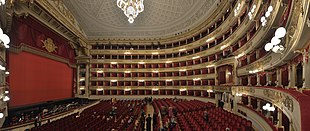
Milan is known as a center for the performing arts. Many influential musicians and composers such as Gioseppe Caimo , Giuseppe Verdi and Giulio Gatti-Casazza lived or worked in the city.
The Teatro alla Scala opera house enjoys an international reputation . Since its opening in 1778, numerous first performances of influential operas have taken place, for example Nabucco by Verdi, La Gioconda by Amilcare Ponchielli , Madama Butterfly and Turandot by Giacomo Puccini . The traditional Piccolo Teatro di Milano was the first permanent theater with a permanent ensemble in Italy when it was founded.
Other large theaters are the Teatro degli Arcimboldi, the Teatro Dal Verme , the Teatro Lirico and the Teatro Regio Ducal. A symphony orchestra has existed since 1993 and performs regularly in the municipal concert hall Auditorium di Milano Fondazione Cariplo.
Fashion
Alongside Paris , New York and London, Milan is one of the world's leading fashion capitals and has a fashion, clothing and textile industry steeped in tradition. Many well-known Italian fashion brands such as Armani , Dolce & Gabbana , Gucci , Prada , Valentino and Versace are based in the city. A well-known shopping street is Via Monte Napoleone . Milan Fashion Week takes place twice a year and is a major event on the international fashion scene.
business

Milan is the leading economic and industrial city in Italy. According to a study from 2014, the greater Milan area generated a gross domestic product of 312.1 billion US dollars (KKB). In the ranking of the economically strongest metropolitan regions worldwide, he finished 34th. The GDP per capita was $ 41,147. Around half of the 200 largest companies in the country are based in Milan. The automotive industry (including Alfa Romeo and Pirelli ), the fashion and clothing industry, the chemical industry, medical technology and biotechnology, mechanical engineering and the financial sector are important branches of the economy .
As the seat of the Italian Stock Exchange and numerous banks (e.g. Banca Sistema , Banco BPM and Mediobanca ) as well as up-and-coming FinTechs (e.g. the robo-advisor Moneyfarm and InsureTech Prima), the city is the country's financial center. In a ranking of the most important financial centers worldwide, Milan came in 61st place (as of 2018). Milan is home to the leading Italian media groups (e.g. Mediaset ), publishers (e.g. Mondadori ) and news agencies, including: the branch of the Italian Public Service Broadcasting ( RAI ). In addition, in recent years many national and international Internet service providers have opened offices in Milan, including age Vista , Google and Yahoo . International trade fairs are, for example, SMAU for computer technology, EICMA for motorcycles or the Milan Furniture Fair. Tourism also makes a significant contribution to economic output. In 2010 the city registered over 2.3 million international visitors.
In a ranking of cities according to their quality of life, Milan took 42nd place out of 231 cities worldwide in 2018. The city was one place behind London and one place before Barcelona .
The Milan Furniture Fair takes place annually in April . It is considered the largest and most important furniture fair in the world.
Concise architecture
The modern cityscape of Milan's center is characterized by high-rise buildings and high-rise complexes, some of which are now under monument protection due to their architectural features or have been awarded architecture prizes for their innovative concept. These include, for example, the Torre Velasca , the Pirelli high-rise , the Torre Unicredit and the planted twin towers Bosco Verticale .
traffic
Long-distance transport
- Highway
Milan is Italy's largest transport hub . This is where the A1 (to Rome and Naples ), A4 ( Turin - Trieste ), A7 (to Genoa ) and A8 / A9 (connection to Switzerland ) motorways intersect . They all flow into the Milan ring road, which is made up of the A50 (west bypass ), A51 (east bypass ) and A52 (north-east bypass ). Due to air pollution and traffic jams, a city toll for cars, trucks and coaches was introduced on weekdays in 2008.
- railroad
The railway junction includes, among other things, the monumental terminal station at Milano Centrale, opened in 1931, and a large marshalling yard (Milano Smistamento) in the east on the route to Venice . Other long-distance train stations in Milan are Milano Porta Garibaldi , Milano Rogoredo and Milano Lambrate . On the long-distance transport level, Zurich , Rome and Naples, among others , can be reached directly from Milan ; on the regional level, there are connections to many larger cities in northern Italy such as Brescia and Bergamo .
- Air traffic
Milan is served by the international airports Linate and Malpensa on the one hand as well as Orio al Serio near Bergamo . Malpensa is an intercontinental hub, while Linate Airport, which is very close to the city center on the outskirts, is mainly used for domestic (especially the Milan-Rome connection) and European air traffic. Milan-Bergamo Airport, 45 km away from Milan, is mainly served by low-cost airlines such as Ryanair and mostly marketed by them as Milan-Orio al Serio .
Local transport

The Lombard railway company Trenord operates a S-Bahn network in the metropolitan area. The public transport system is, among other things by the municipal public transport company ATM Milano performed.
With the Milan tram , the city has one of the largest tram networks in Europe. With the so-called Type 1928 , pre-war US-style trams are still in use in Milan today , built between 1928 and 1930. The tram is supplemented by the Milan trolleybus .
The express rail traffic is marked with MSR - these letters stand for the U-Bahn (Metro) , the S-Bahn (Linee Suburbane) and the regional traffic.
science and education

In 2011, around 185,000 students were enrolled at seven universities with a total of 48 faculties, which corresponds to around 11% of all Italian students.
The Technical University ( Politecnico di Milano ) is the oldest university in Milan. The university, founded in 1863, comprises 16 departments and nine affiliated institutes for engineering, architecture and design. With around 38,000 enrolled students, it is the largest technical university in Italy.
The University of Milan , founded in 1923, is the largest university in Milan and comprises nine faculties with 58 departments and 48 institutes. It is the sixth largest university in Italy with 60,000 enrolled students and 2,500 professors.
The private Luigi Bocconi University of Economics has offered a degree in economics and law since 1902 and offers around 12,800 students a place. The Catholic University of the Sacred Heart is headquartered in Milan and with a total of 14 faculties and around 42,000 students enrolled at five locations is the largest private university in Europe and the largest Catholic university in the world.
Milan also has well-known academies and art schools. The Milan Academy of Fine Arts was founded by the Austrian Empress Maria Theresa in 1776 , and the New Academy of Fine Arts is the largest private institution of its kind in Italy. The Conservatorio Giuseppe Verdi has been teaching since 1807 and is now the largest music academy in Italy with 1700 students and 240 music teachers.
Sports
Milan is home to the soccer clubs AC Milan and Inter Milan , the two clubs are among the most successful soccer clubs in the world and are part of one of the most famous soccer derbies in the world, the Derby della Madonnina . Milan is the only city that is home to two UEFA Champions League winners. Both clubs play their home games in the Giuseppe Meazza Stadium in the San Siro district , one of the largest in Europe with a capacity of over 80,000. A third club, the Brera Calcio , plays in the Lega Nazionale Dilettanti and plays its home games in the Arena Civica .
In rugby , which is particularly popular in northern Italy , Milan is represented by the Amatori Rugby Milano team, which holds the Campionato di Eccellenza record with 18 championship wins . In basketball, Olimpia Milano is the leader in Italy with 26 national titles and three European Cups . Milan teams also dominate in ice hockey: a total of eight different teams brought 32 championships to the city.
The Milan – Sanremo cycle race is also the longest one-day race in professional cycling with over 290 kilometers . The Giro d'Italia cycle tour traditionally ends in Milan. The well-known race track in Monza , on which Formula 1 is a guest once a year , is located north of the city.
Olympic Winter Games 2026
Together with Cortina d'Ampezzo, Milan is the venue for the XXV. Olympic Winter Games 2026 .
Twin cities
-
 Bethlehem , Palestinian Territories
Bethlehem , Palestinian Territories
-
 Birmingham , UK
Birmingham , UK
-
 Chicago , United States
Chicago , United States
-
 Dakar , Senegal
Dakar , Senegal
-
 Frankfurt am Main , Germany
Frankfurt am Main , Germany
-
 Guadalajara , Mexico
Guadalajara , Mexico
-
 Krakow , Poland
Krakow , Poland
-
 Lyon , France
Lyon , France
-
 Manila , Philippines
Manila , Philippines
-
 Melbourne , Australia
Melbourne , Australia
-
 Osaka , Japan
Osaka , Japan
-
 Saint Petersburg , Russia ( suspended since November 2012 in protest against the laws against "homosexual propaganda" in force in Saint Petersburg )
Saint Petersburg , Russia ( suspended since November 2012 in protest against the laws against "homosexual propaganda" in force in Saint Petersburg ) -
 São Paulo , Brazil
São Paulo , Brazil
-
 Shanghai , China
Shanghai , China
-
 Tel Aviv-Jaffa , Israel
Tel Aviv-Jaffa , Israel
-
 Toronto , Canada
Toronto , Canada
Personalities
Famous personalities of the city are included in the list of personalities of the city of Milan. These include the publicist and politician Ernesto Teodoro Moneta , the composer Nino Rota , the politician Silvio Berlusconi , the pianist Maurizio Pollini and the painter, engineer and natural philosopher Leonardo da Vinci, who worked in the Duchy of Milan .
Web links
|
Further content in the sister projects of Wikipedia:
|
||
|
|
Commons | - Media content (category) |
|
|
Wiktionary | - Dictionary entries |
|
|
Wikiquote | - Quotes |
|
|
Wikivoyage | - Travel Guide |
- City of Milan website (multilingual)
- Marianne Bauer: Milan (city). In: Historical Lexicon of Switzerland .
- Angela Pachovsky: Milan. In: Oesterreichisches Musiklexikon . Online edition, Vienna 2002 ff., ISBN 3-7001-3077-5 ; Print edition: Volume 3, Verlag der Österreichischen Akademie der Wissenschaften, Vienna 2004, ISBN 3-7001-3045-7 .
- Milan on the ETHorama platform
Individual evidence
- ↑ Statistiche demografiche ISTAT. Monthly population statistics of the Istituto Nazionale di Statistica , as of December 31 of 2019.
- ↑ AA. VV., Dizionario di toponomastica. Storia e significato dei nomi geografici italiani, Torino, UTET, 1990.
- ^ OECD : Territorial Reviews. Milan, Italy. (PDF; 3.2 MB) p. 29 , archived from the original on July 27, 2011 ; accessed on March 4, 2018 .
- ↑ Demographia World Urban Areas, 2017 (PDF; 1.8 MB)
- ^ Article "Milan" in the Online Etymology Dictionary .
- ↑ www.etymologie.info
- ↑ Milan on the ETHorama platform
- ↑ Milan on the ETHorama platform
- ^ Information from the Italian Ministry of the Interior. Archived from the original on August 11, 2011 ; Retrieved May 31, 2011 .
- ↑ Milano, il sindaco Sala aderisce ai Verdi europei - Attualità | l'Adige.it. Retrieved September 6, 2021 (italiano).
- ↑ Mudec Official Website (Italian, English)
- ^ Alan Berube, Jesus Leal Trujillo, Tao Ran, and Joseph Parilla: Global Metro Monitor . In: Brookings . January 22, 2015 ( brookings.edu [accessed July 19, 2018]).
- ↑ The Global Financial Centers Index 23. (No longer available online.) Archived from the original on March 27, 2018 ; accessed on July 13, 2018 .
- ↑ Mercer's 2018 Quality of Living Rankings. Retrieved July 30, 2018 .
- ↑ Archived copy ( Memento of May 13, 2013 in the Internet Archive ), "Universities in Milan" (English)
- ↑ Milan to host the 2026 Winter Olympics : www.ZEIT-ONLINE.de (June 24, 2019 edition).
- ^ Resolution of the Milan City Council of November 22, 2012. See: kontury.info ( accessed online on November 30, 2012) and milanotoday.it ( accessed online on November 30, 2012).


